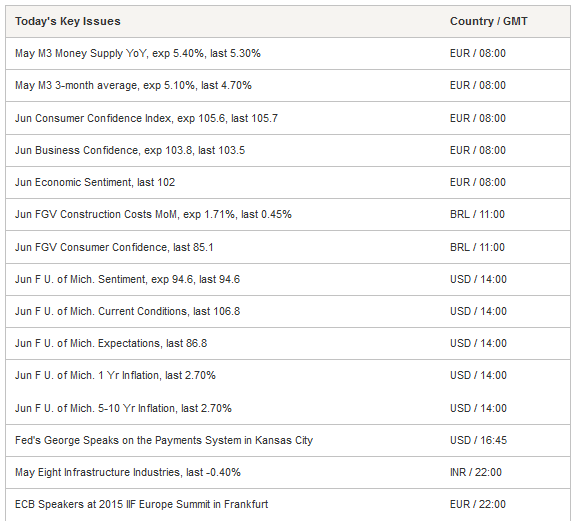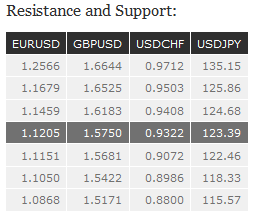Forex News and Events
RBNZ is committed to devaluate the Kiwi (by Arnaud Masset)
The Reserve of New Zealand released its Statement of Intent for 2015-2018 and seized the opportunity to tirelessly repeat that the “unjustifiable and unstainable levels” of the New Zealand dollar significantly hurt the Kiwi economy together with current weakness in the Australian and Chinese economy and a sharp drop in Dairy prices. CPI was consistently below the 2% target and even below the 1%-3% target range since Q3 2014; in addition markets do not expect inflation to move within the target range before Q4 2015. Moreover, according to the latest forecast, we should wait until Q2 2016 to see inflation back around 2%. After a rate cut of 25bps in June, the dovish stance of the RBNZ coupled with low inflation pressures suggest that the Bank is not done with monetary easing moves yet. We therefore expect the RBNZ to lower its official cash rate to 3% at its next meeting (July 23) and the Kiwi to continue its free fall against the greenback.
To anchor inflation expectations
In Brazil, the National Monetary Council (CMN) tightened the inflation target range for 2017 from +/-2% to +/-1.5% but maintained the mid-point to 4.5%. The move will surely increase the credibility of the BCB as the Bank send a strong signal to markets that it is committed to the inflation target regime. By reducing the target band, the BCB will therefore need to be more vigilant to make sure inflation meets the new objectives. On the data front, unemployment rate rose faster than expected in May to reach 6.7% versus 6.6% expected and 6.4% prior read. Unemployment rate is gaining momentum - it printed at 5.3% in January 2015 – as the Brazilian economy is contracting further and the BCB keeps tightening monetary conditions to control high inflation levels. Latest fiscal data proved to be weak again and printed at BRL91.5mn in May versus 109.2mn previous month. We do not expected federal tax revenue to improve substantially over the coming months as the rise of unemployment rate will weighs on tax collection and increases social expenses.
Japan moves away from deflation (by Yann Quelenn)
Yesterday, important data came in for Japan, in particular the jobless rate that printed at 3.3% in May. It remains unchanged from the previous month. In addition, inflation increased by 0.5% year-on-year, despite the decline from April.
Major part of the Abenomics strategy is to stimulate inflation through consumers spending. For the time being, Shinzo Abe’s policy seems to work and new data tend to show that the country is exiting twenty years of economic slowdown. However, fears of deflation seems still there and therefore, Central Bank’s remains under pressure. Key issues is Japan retail sales that remained low and, especially not at the needed level for a sustainable recovery. New retail sales data for May will come in next Monday.
It is also very likely that policymakers’ officials are unhappy with the yen’s collapse over the last few years. The USD/JPY is now trading around its highest level since 13 years. Obviously, the QQE effect made the yen weaker, which pushed up the exporter’s revenues and stock prices amid imports cost went higher.
We think further monetary easing will continue until the inflation target of 2% is reached. USDJPY is trading around 123.43 and is likely to push again toward 124.00 against the backdrop of US recovery. We now expect a Q2 GDP confirming good first quarter figures.
AUD/USD - Challenging Rising Trend-Line


The Risk Today
Yann Quelenn
EUR/USD is now trading sideways around 1.1200. Hourly resistance lies at 1.1436 (18/06/2015 high). Stronger resistance is given at 1.1459 (15/05/2015 high). We expect the pair to decline toward hourly support at 1.1050 (05/06/2015 low). In the longer term, the symmetrical triangle from 2010-2014 favors further weakness towards parity. As a result, we view the recent sideways moves as a pause in an underlying declining trend. Key supports can be found at 1.0504 (21/03/2003 low) and 1.0000 (psychological support). Break to the upside would suggest a test of resistance at 1.1534 (03/02/2015 reaction high).
GBP/USD is still trading between the hourly resistance at 1.5930 (18/06/2015 high) and 1.5626 (17/06/2015 low). There is an upside momentum and we expect the pair to challenge the resistance at 1.5930. In the longer term, the technical structure looks like a recovery bottom whose maximum upside potential is given by the strong resistance at 1.6189 (Fibo 61% entrancement).
USD/JPY remains in range between the hourly support at 122.46 (10/06/2015 low) and the hourly resistance at 124.62 (10/06/2015). We expect the pair to bounce at this level and to challenge again the support at 122.46. Key resistance still lies at 135.15 (14-year high). A long-term bullish bias is favored as long as the strong support at 115.57 (16/12/2014 low) holds. A gradual rise towards the major resistance at 135.15 (01/02/2002 high) is favored. A key support can be found at 118.18 (16/02/2015 low).
USD/CHF has broken the resistance at 0.9408 (11/06/2015 high) before bouncing back below this level. Stronger resistance can be found at 0.9573 (29/05/2015 high). Hourly support can be found at 0.9151 (18/06/2015 low). In the short-term, the pair is setting lower highs, therefore we remain bearish over the next few weeks. In the long-term, there is no sign to suggest the end of the current downtrend. After failure to break above 0.9448 and reinstate bullish trend. As a result, the current weakness is seen as a counter-trend move. Key support can be found 0.8986 (30/01/2015 low).

